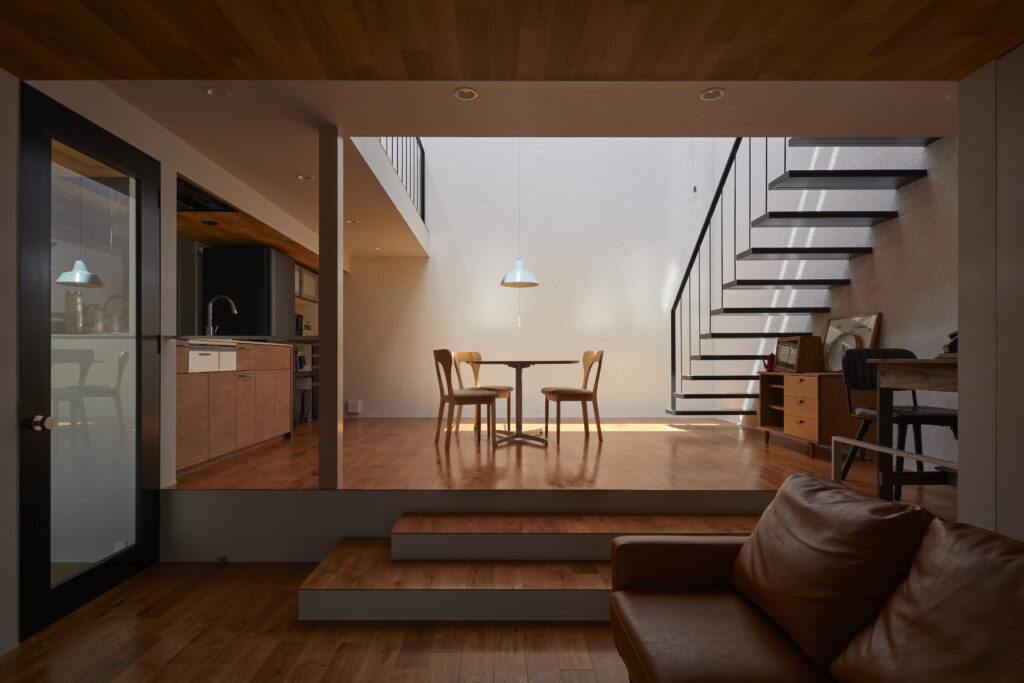
Photo by Tomoyuki Kusenose

Photo by Tomoyuki Kusenose

Photo by Tomoyuki Kusenose

Photo by Tomoyuki Kusenose

Photo by Tomoyuki Kusenose

Photo by Tomoyuki Kusenose
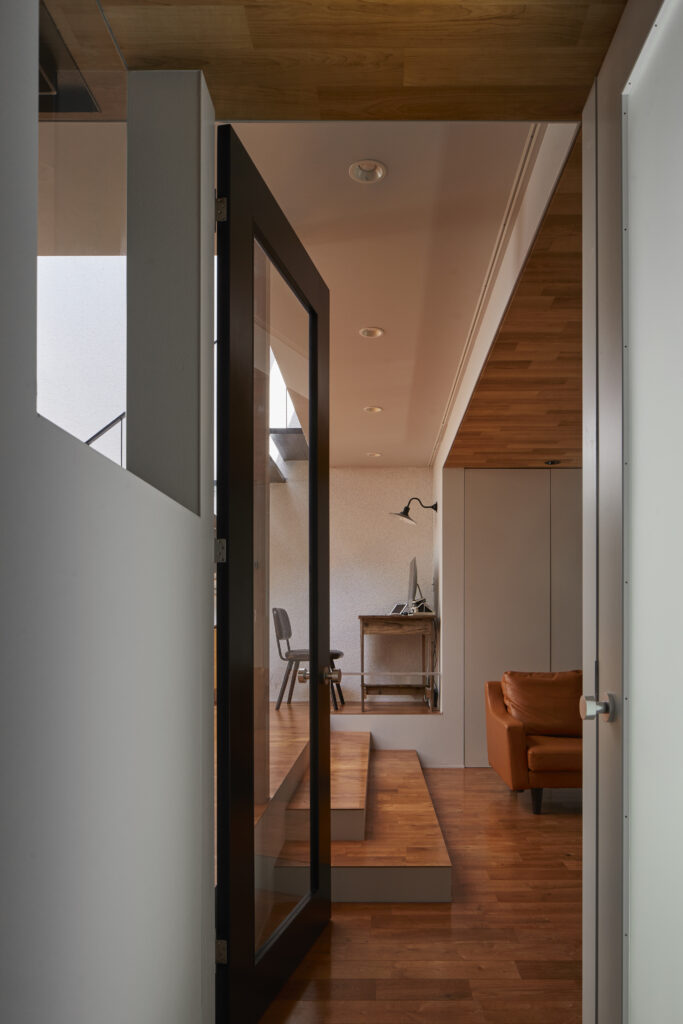
Photo by Tomoyuki Kusenose
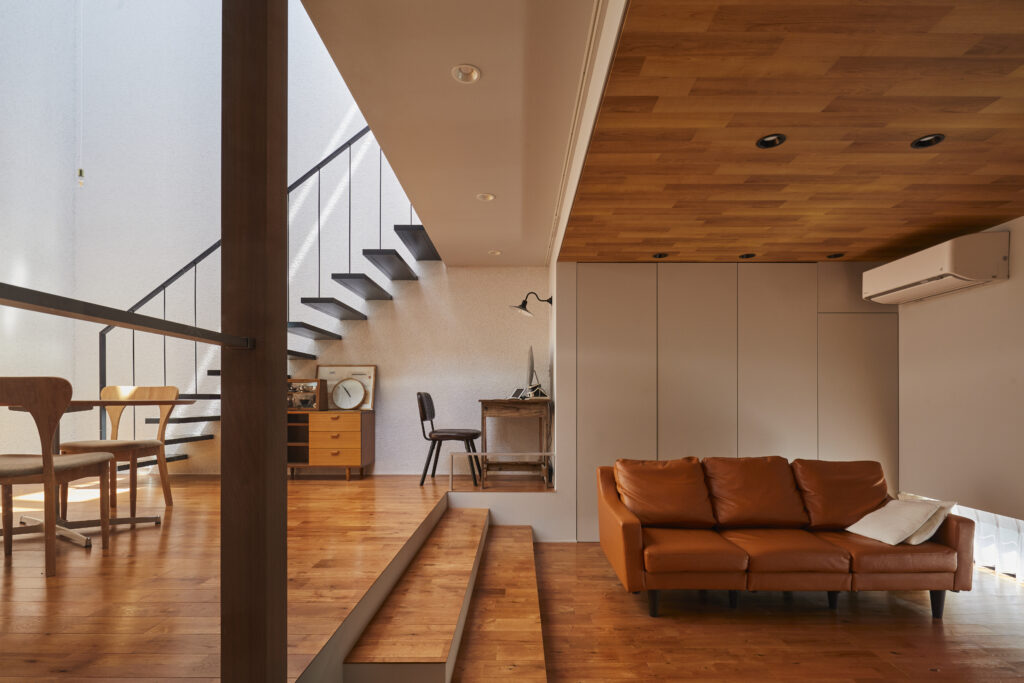
Photo by Tomoyuki Kusenose
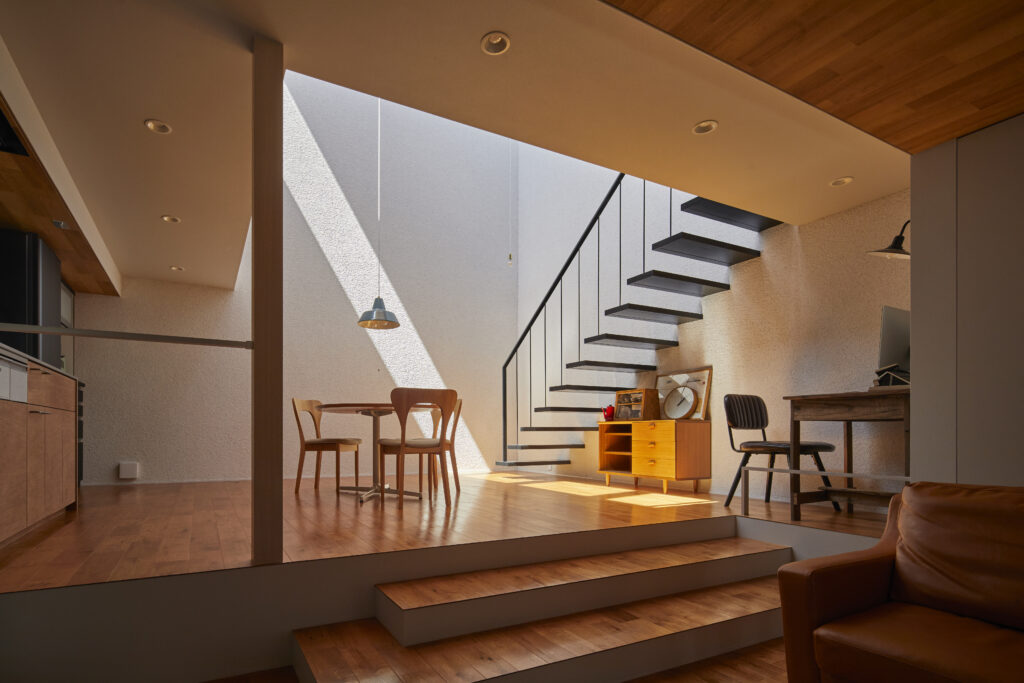
Photo by Tomoyuki Kusenose

Photo by Tomoyuki Kusenose
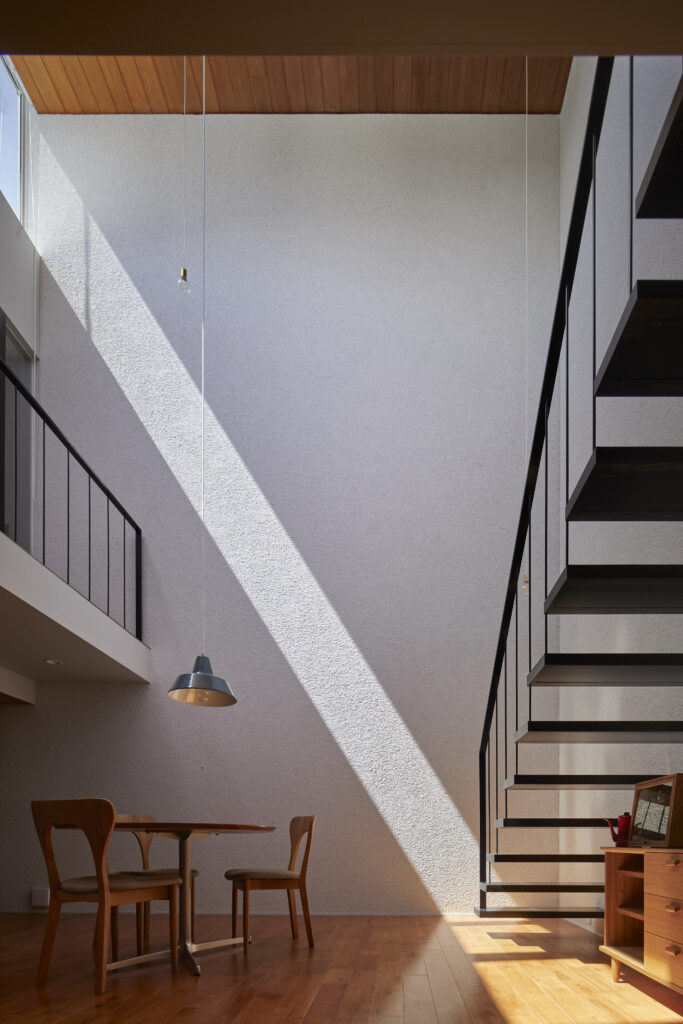
Photo by Tomoyuki Kusenose
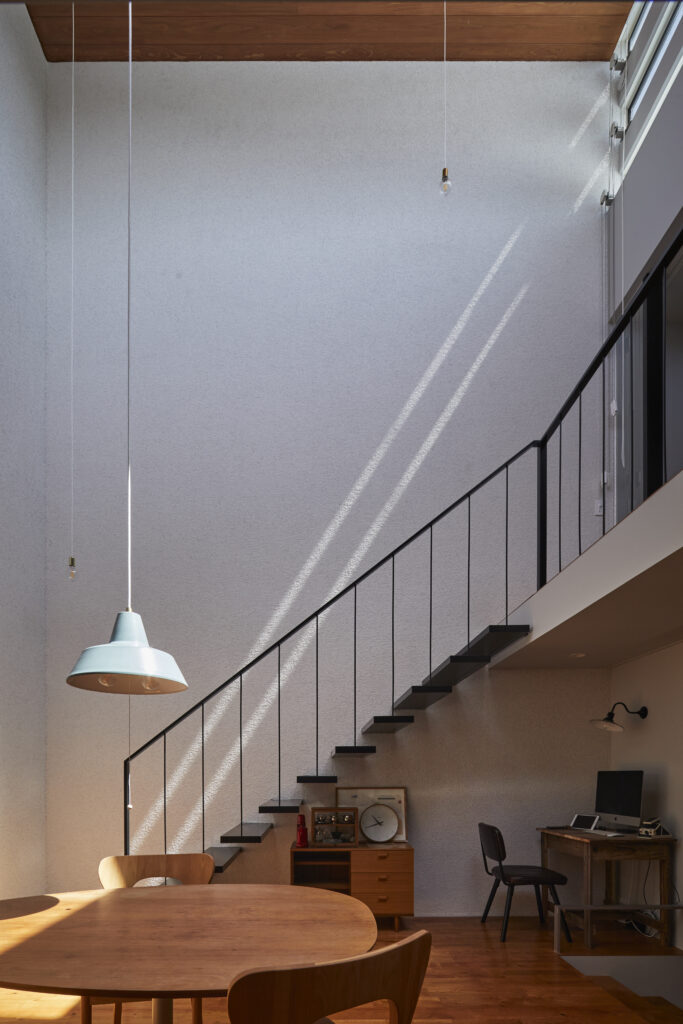
Photo by Tomoyuki Kusenose
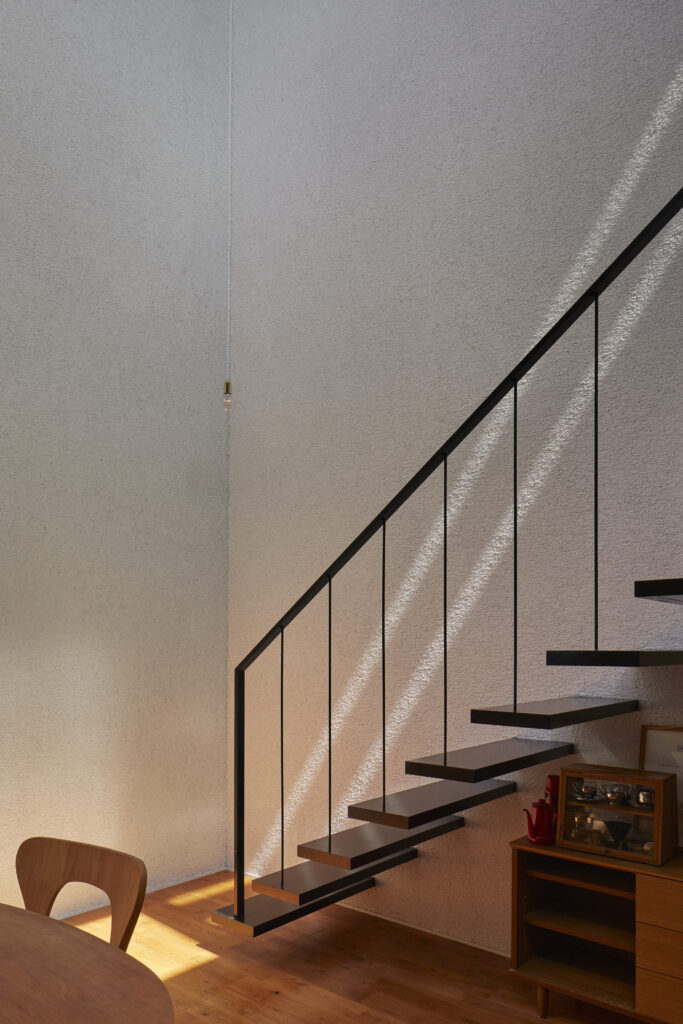
Photo by Tomoyuki Kusenose
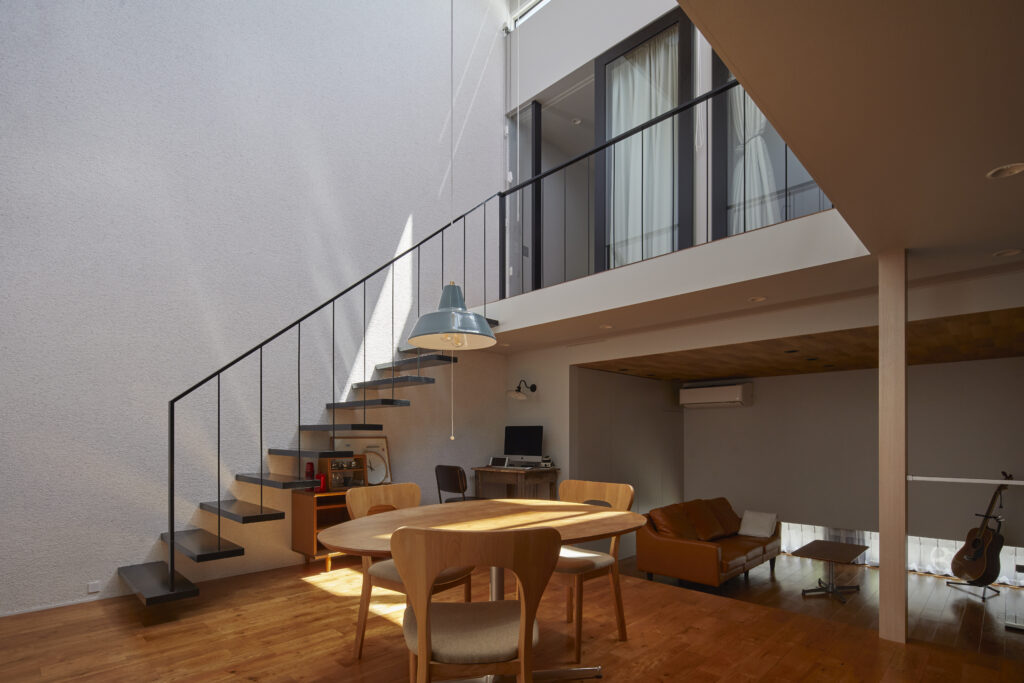
Photo by Tomoyuki Kusenose
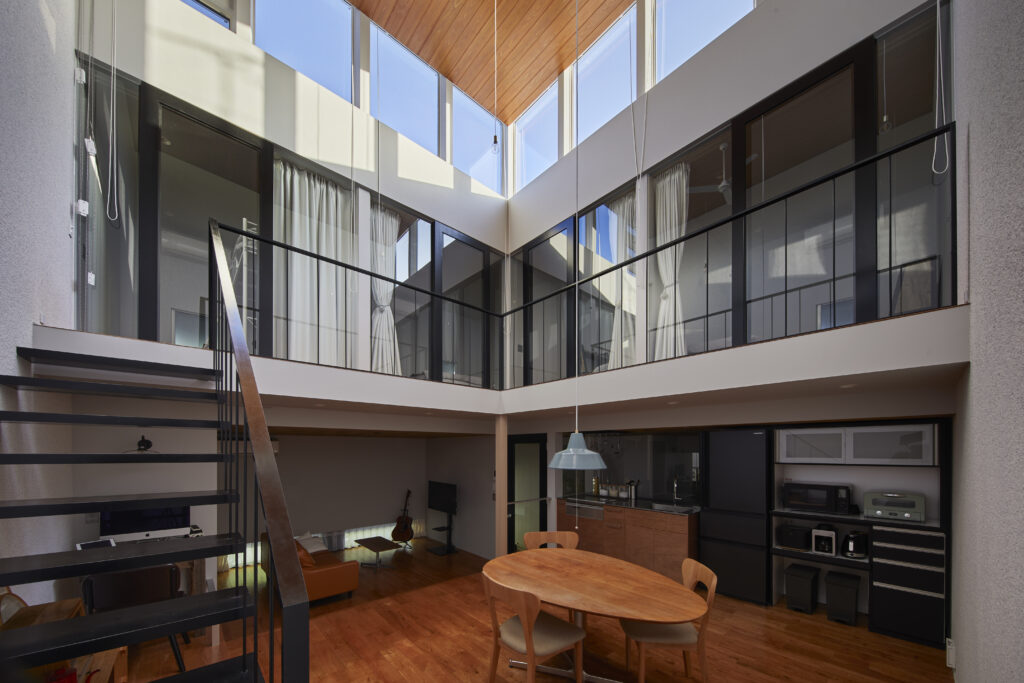
Photo by Tomoyuki Kusenose
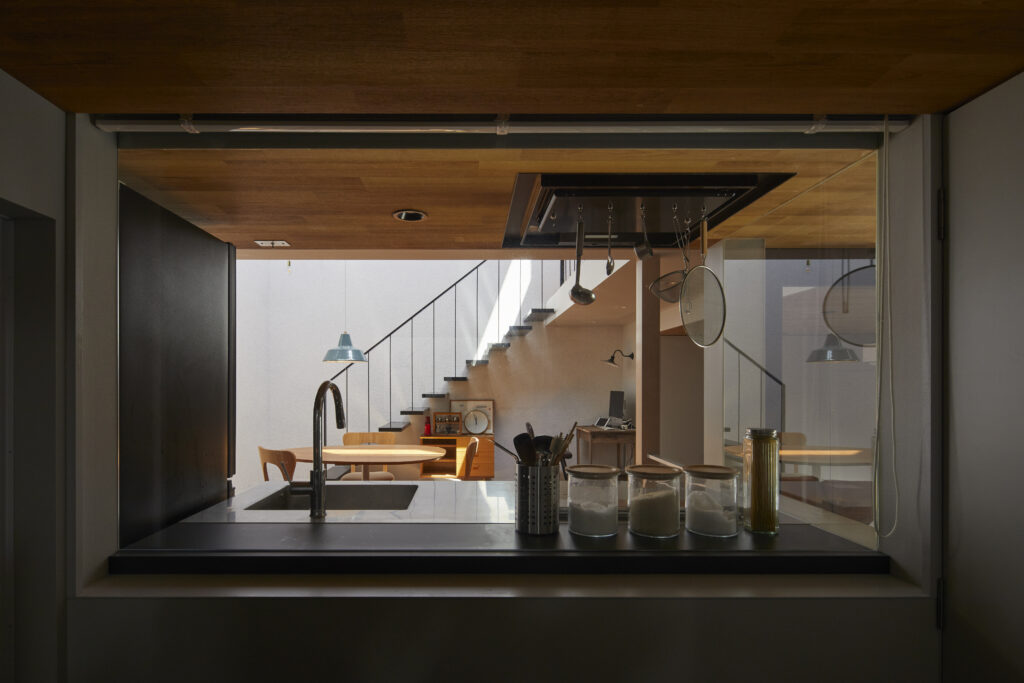
Photo by Tomoyuki Kusenose
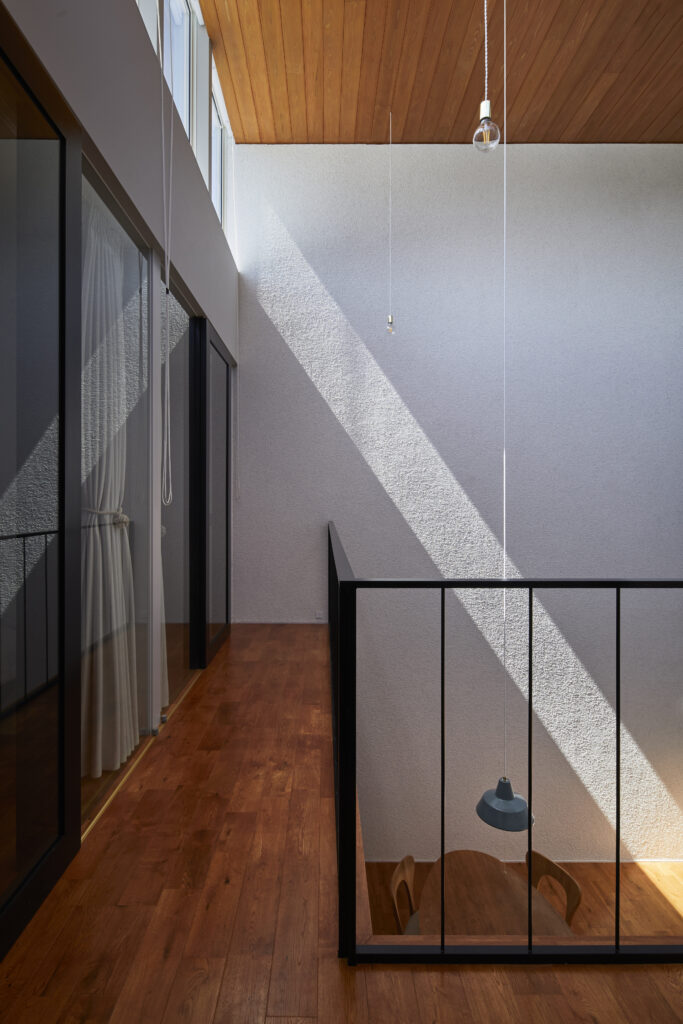
Photo by Tomoyuki Kusenose
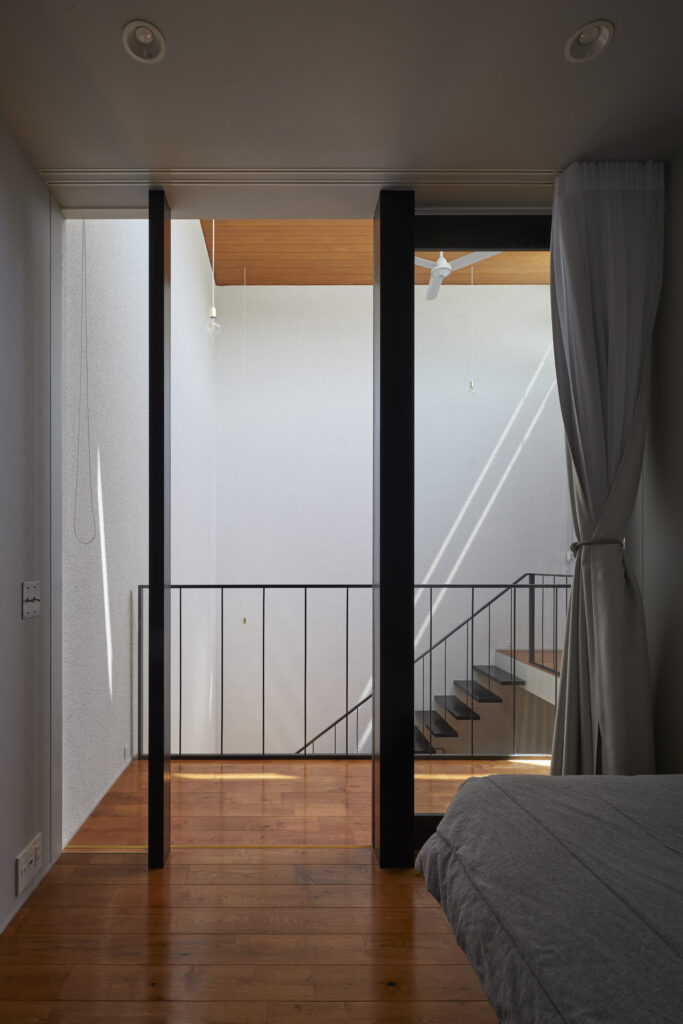
Photo by Tomoyuki Kusenose
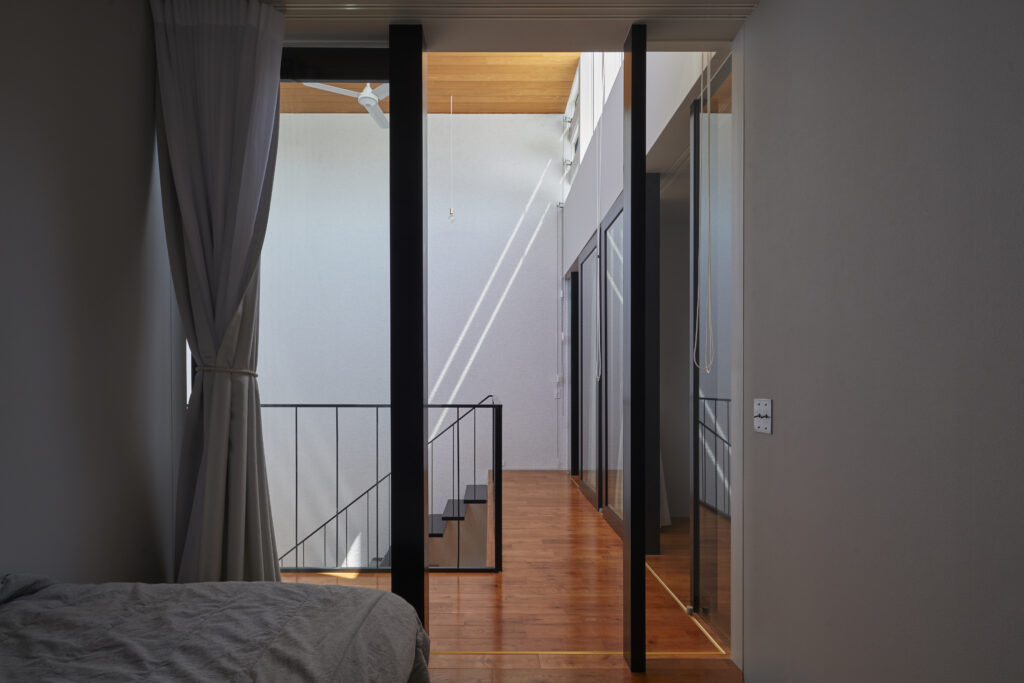
Photo by Tomoyuki Kusenose
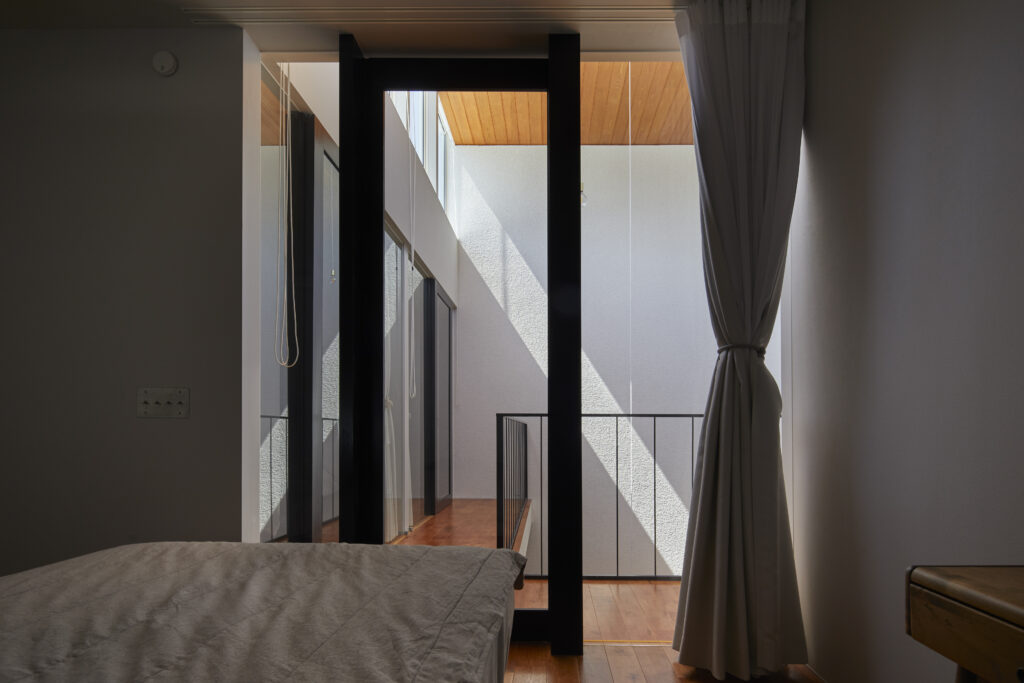
Photo by Tomoyuki Kusenose
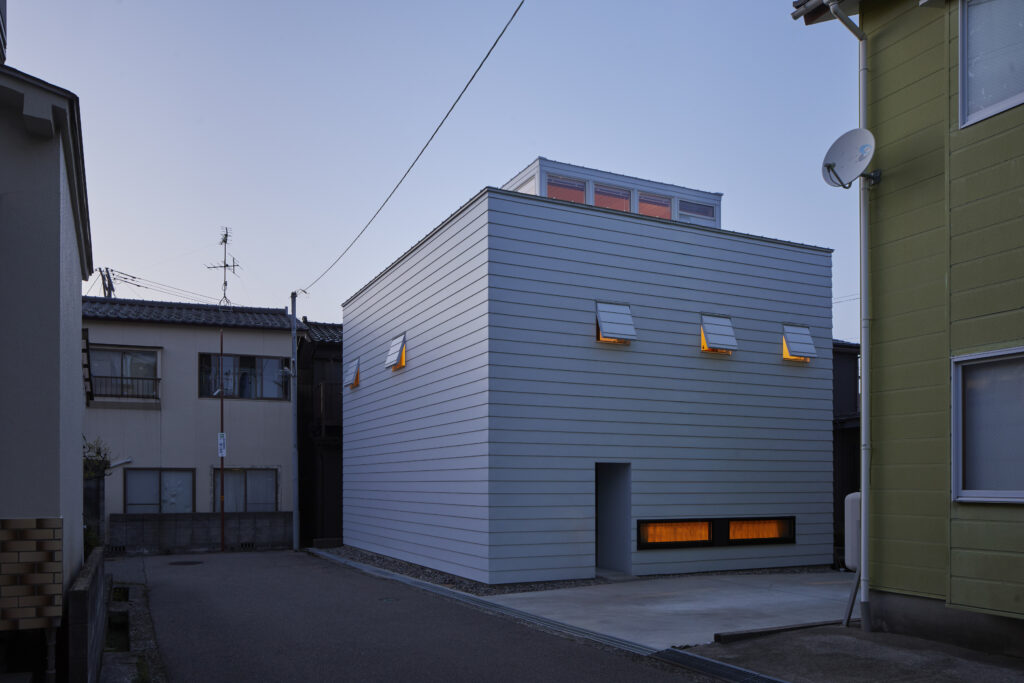
Photo by Tomoyuki Kusenose
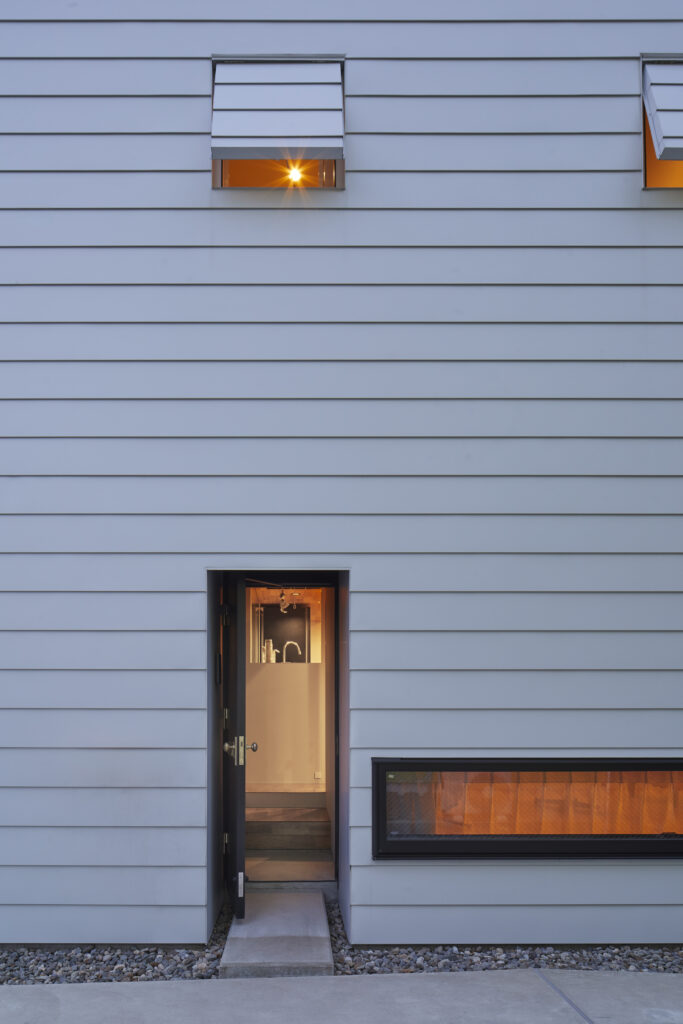
Photo by Tomoyuki Kusenose
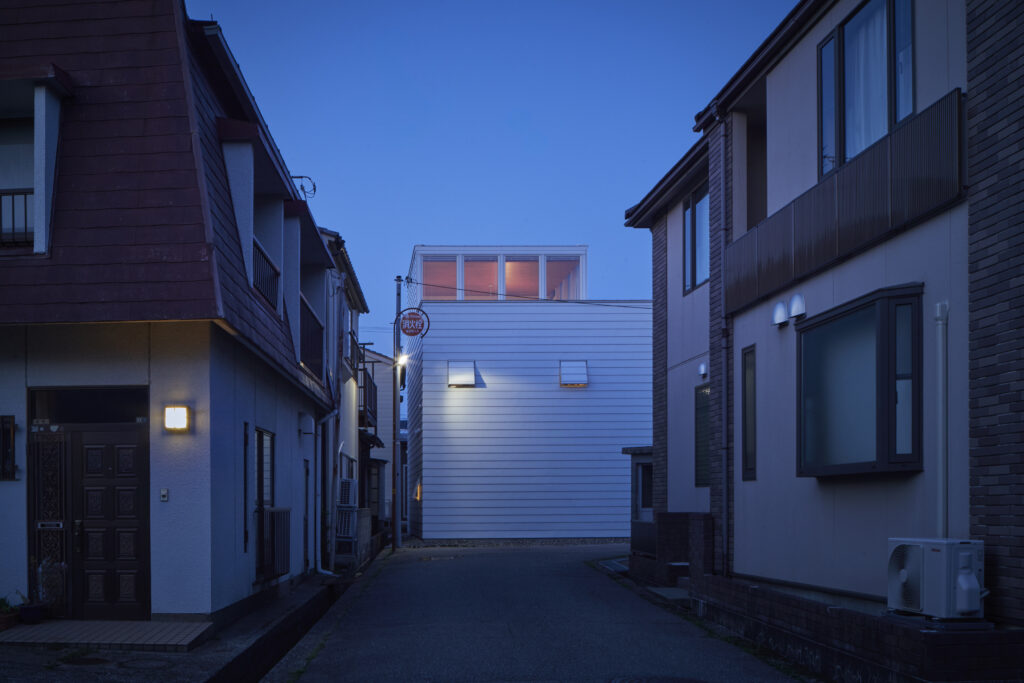
Photo by Tomoyuki Kusenose
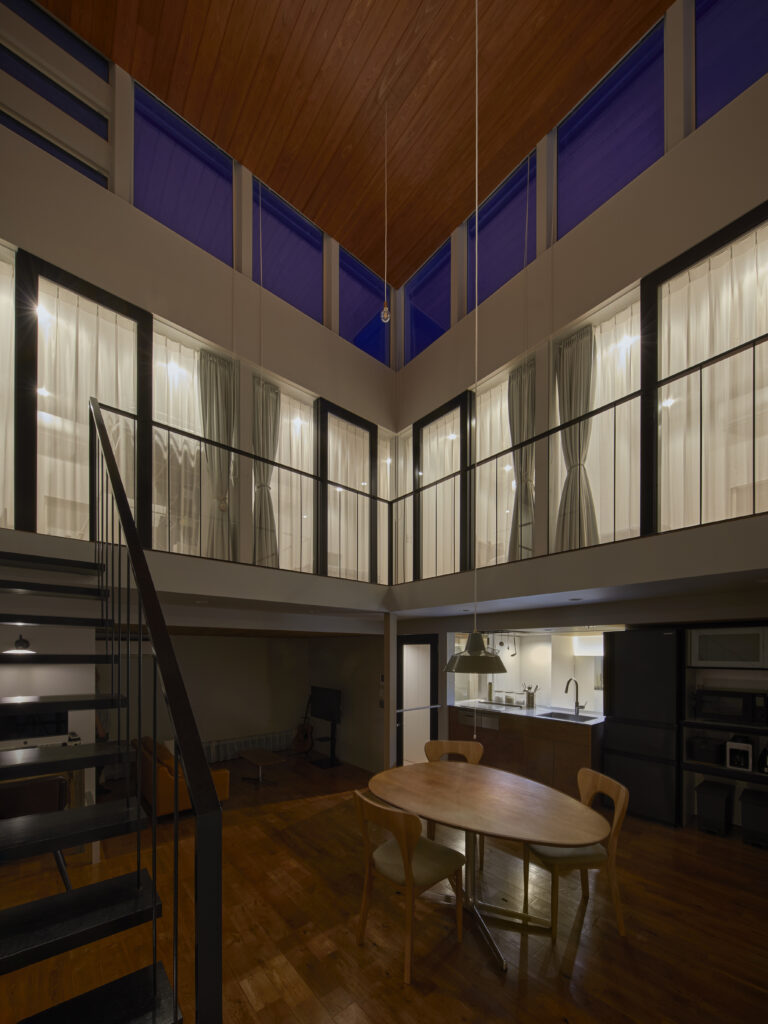
Photo by Tomoyuki Kusenose
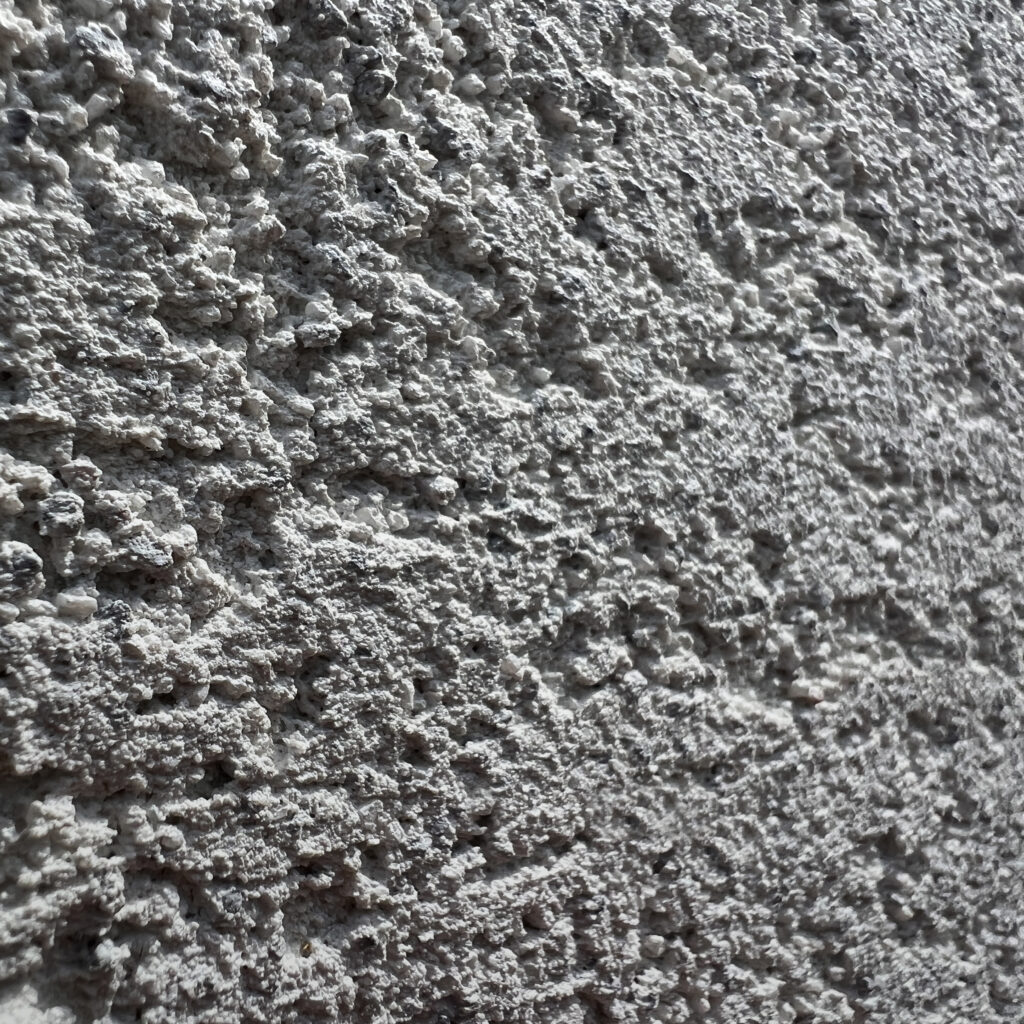
「脱炭素時代の住宅密集地における自然密接型住宅の一例」
(English Below)
この建物は、一年を通して悪天候の多い北陸地方を敷地とする、脱炭素時代の住宅密集地における自然密接型住宅の一例である。一極集中した採光窓から吹抜けを通して建物全体で太陽光の採光を共有することで建物全体の採光窓面積を減らしUA値(外皮平均熱損失量)の低減を図った。建物のUA値は「ZEH基準(金沢市) 0.60」を下まわる「0.56」である。同性能の断熱材を用いた標準的な窓面積の住宅で0.60程度であることと比べて、この建物では標準的な住宅より延べ床面積が少なく計算上不利であるにも関わらず、明確な低減を実現している。(施工担当住宅メーカーの実例情報による比較)
一般住宅では稀な3層吹抜けの最上部に建物全体の採光窓を集中的に配置することで一般的な住宅にある窓際より明るい窓際が生まれ、光の明暗対比が強調された非日常的な縦長空間を住宅内に作り出した。また、採光窓の一極集中は光の指向性を高め、壁素材や床、家具等の凹凸による陰影のコントラストを高め、3層吹抜けの音の響き効果とともに、屋内空間の立体感や奥行きを強調し、まるで屋外のような吹抜け空間を演出している。
2階個室においては、吹抜け側の壁面を全面ガラスにし、太陽光を外壁側でなく屋内吹抜け側でとることで、熱損失を抑えつつも開放的な採光窓を実現した。屋内の採光窓は簡素な納まりで透明感を感じさせられる木製建具で製作可能なため、明るい吹抜け空間と一体的な個室空間が実現されている。
春や秋の中間期は、建物最上部の換気窓、各個室の窓や1階ソファーコーナーの換気窓からかなりの量の風が吹抜けを吹き抜ける。比較的小さな空間が、明るさだけではなく風と音で、よりいっそう屋外的な空気へと変化する。
夏は吹抜け空間における気圧換気により余計な熱を排出したり、駐車場コンクリート土間への散水気化熱による冷気の取り込みを可能としている。
冬は吹抜けに多量の太陽光を取り込むことで温室効果を得て、シーリングファンの空気循環により1階から最上階までの建物の全体的な空気を温めることができる。
建物最上部に太陽光の動きを取り込める水平に連続したアルミサッシガラス面を設け、アルミ製の横型ブラインドの角度調整により、その面から入る太陽光による明るさを建主が生活に合わせ適切に調整できる。太陽光の動きや換気窓から抜ける風の動きを感じたり、観葉植物が太陽光の下で生き生きした姿を見せる屋内空間は、自然環境が建主の生活の各場面で身体の活力や癒しにつながることにもなり、季節に関わらずまるで一年中屋内に晴れている庭を設えているような住宅となっている。
各階の天井高さや階高は1階を低く天井高2.2m(階高2.7m)、2階を高く天井高2.5mとしている。これにより1階ソファーコーナーは天井高さが2.2mと低い落ち着いた空間となり、ソファーコーナーから床が400mm上がったラウンジ空間は2階の廊下や個室との距離が極端に近く相互コミュニケーションの可能性を感じさせる空間となっている。また、一般的な2.5mの天井高さにも関わらず床面積を小さくした2階の各個室は、縦長の開放性をもち、総長6.6mの縦長の吹抜け砂質塗り壁がつくる光のグラデーションを効果的に切り取った開口を持った空間とした。2階廊下は上部への開放性と、下階の家族や植物との近接感を備えており、椅子を持ち出した軽作業など、機能上活用しやすい空間とした。
太陽光の動きが作る風景を最も美しく感じられるのは1階のソファーコーナーである。
天候による雲の動きや、季節と時間の経過によって変化する砂質塗り壁の縦方向の光と影のグラデーション。太陽光に向け上方向に生き生き育つ観葉植物。吹抜け上部から吊り下げられたペンダント照明とそれを吊るすまっすぐなコード。そういった、ラウンジや吹き抜けの縦方向の光の集まりを床段差で上方に上っていく水平のパノラマとして切り取ることで、縦横の各方向性が強調された美しい風景をつくりだしている。
日本人の身体にも馴染むように天井の高さが抑えられ明るさが抑えられた落ち着きのあるソファーコーナー。そこから眺める3層吹抜けの砂質壁に映し出される自然の作り出す光の大きさや動きは、薄暗い日本の伝統建築の居室から、高さが抑えられた縁側開口を通して、空から豊かな光が降り注ぐ屋外庭を眺める経験にも似ている。
このように脱炭素化を図りつつも、建主が自然を身近に感じられる住宅の一例を体現することができた。この建築が我々が直面している地球環境時代における一つの解として、少しでも多くの方の共感を得られると嬉しい。
・
・
“An example of close-in nature housing in a densely populated decarbonized area“
This building is located in the Hokuriku region, where inclement weather is common throughout the year. The building’s UA value (average heat loss per unit of the building envelope) was reduced by reducing the area of light windows in the building as a whole by sharing sunlight throughout the building from the centralized light windows through the atrium. The UA value of the building is 0.56, which is lower than the ZEH standard (Kanazawa City) of 0.60. This is a clear reduction compared to the value of a house with a standard window area using the same performance insulation material. (From a comparison with an actual case of a housing manufacturer in charge of construction)
By concentrating the lighting windows of the entire building at the top of the three-story atrium, which is rare in general housing, a brighter window area was created than that in general housing, creating an extraordinary vertical space in the house that emphasizes the contrast between light and dark. The concentration of the windows enhances the directionality of the light, and the contrast of shading caused by the unevenness of the wall material, floor, and furniture, as well as the sound effect of the three-story atrium, emphasizes the three-dimensionality and depth of the interior space, creating an outdoor-like atrium space.
In the second-floor private rooms, the walls on the atrium side are entirely made of glass, allowing sunlight to enter not from the exterior walls but from the interior atrium side, thereby reducing heat loss and creating an open, well-lit window. The interior lighting windows can be manufactured with simple wooden fittings that give a sense of transparency, creating a bright atrium space and an integrated private room space.
During the spring and fall mid-seasons, a considerable amount of wind blows through the atrium from the ventilation windows at the top of the building, the windows in each private room, and the ventilation windows in the sofa corner on the first floor. The relatively small space is transformed into a more outdoor atmosphere not only by the brightness but also by the wind and sound.
In summer, the air pressure ventilation in the atrium space allows excess heat to be discharged and cool air to be drawn in by the evaporative heat of water sprinkled on the concrete dirt floor of the parking lot.
In winter, a large amount of sunlight is captured in the atrium to create a greenhouse effect, and the air circulation of ceiling fans warms the overall air of the building from the first floor to the top floor.
The top of the building has a continuous horizontal aluminum sash glass surface that allows sunlight to move in, and the angle of the horizontal aluminum blinds can be adjusted to allow the owner to adjust the brightness of the sunlight coming in from that surface to suit his or her lifestyle. The indoor space where one can feel the movement of sunlight and wind through the ventilation windows, and where the houseplants look alive under the sunlight, leads to a natural environment that energizes and heals the body in every aspect of the owner’s life, making the house feel as if it has a sunny garden indoors all year round, regardless of the season.
The ceiling height and floor height of each floor is set to be 2.2m (2.7m floor height) with a low ceiling on the first floor and a high ceiling of 2.5m on the second floor. This makes the sofa corner on the first floor a calm space with a low ceiling height of 2.2 m. The lounge space, with its floor raised 400 mm from the sofa corner, is extremely close to the corridor and private rooms on the second floor, creating the possibility of mutual communication. The second-floor corridor has an openness to the upper floor and a sense of proximity to the family and plants on the lower floor. The second-floor corridor is open to the upper floor and has a sense of proximity to the family and plants on the lower floor, making it a space that can easily be used for functional purposes, such as light work with a chair.
The most beautiful place to enjoy the scenery created by the movement of sunlight is the sofa corner on the first floor.
The vertical gradation of light and shadow on the sandy painted walls changes with the passage of time and the seasons, as well as the movement of clouds due to weather conditions. Life upward toward the sunlight.
